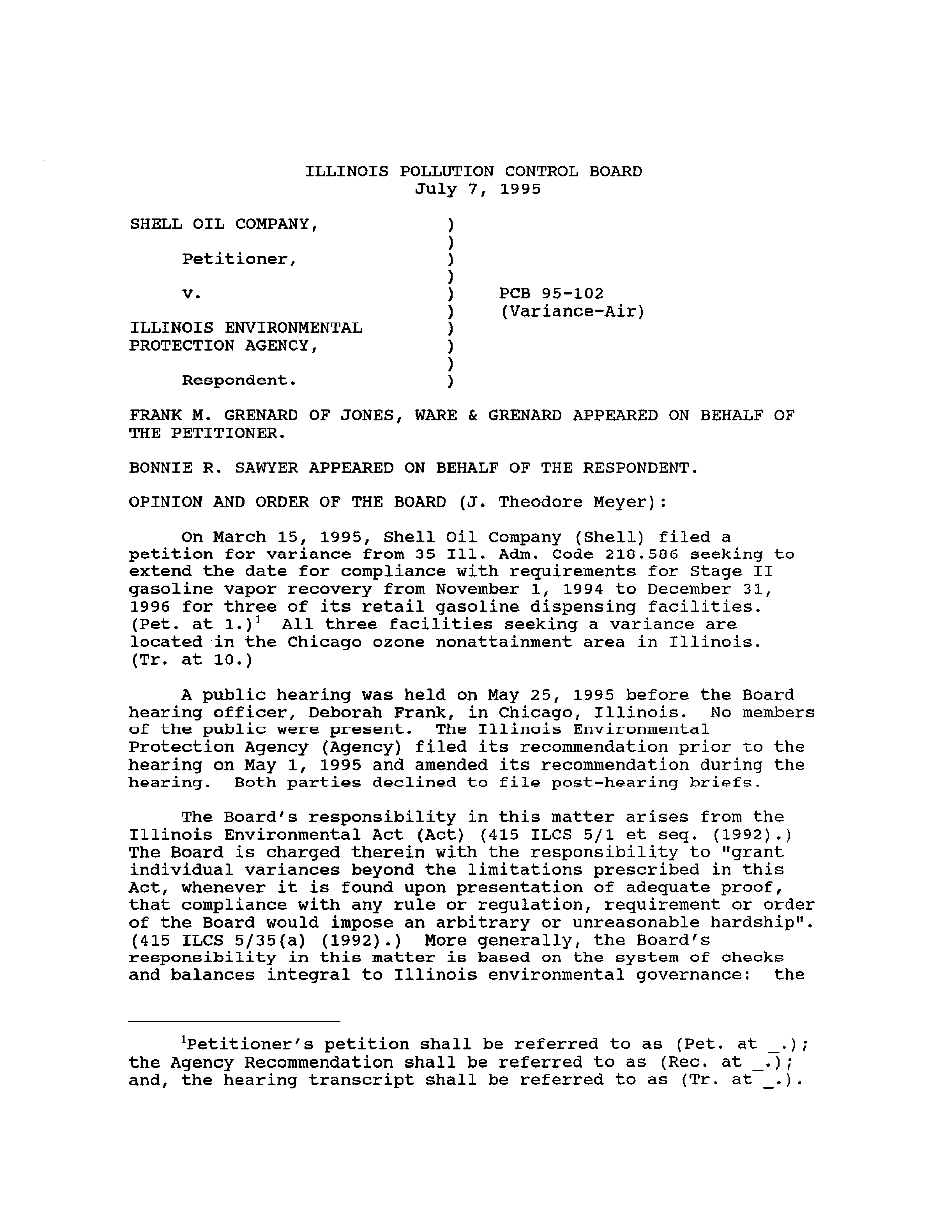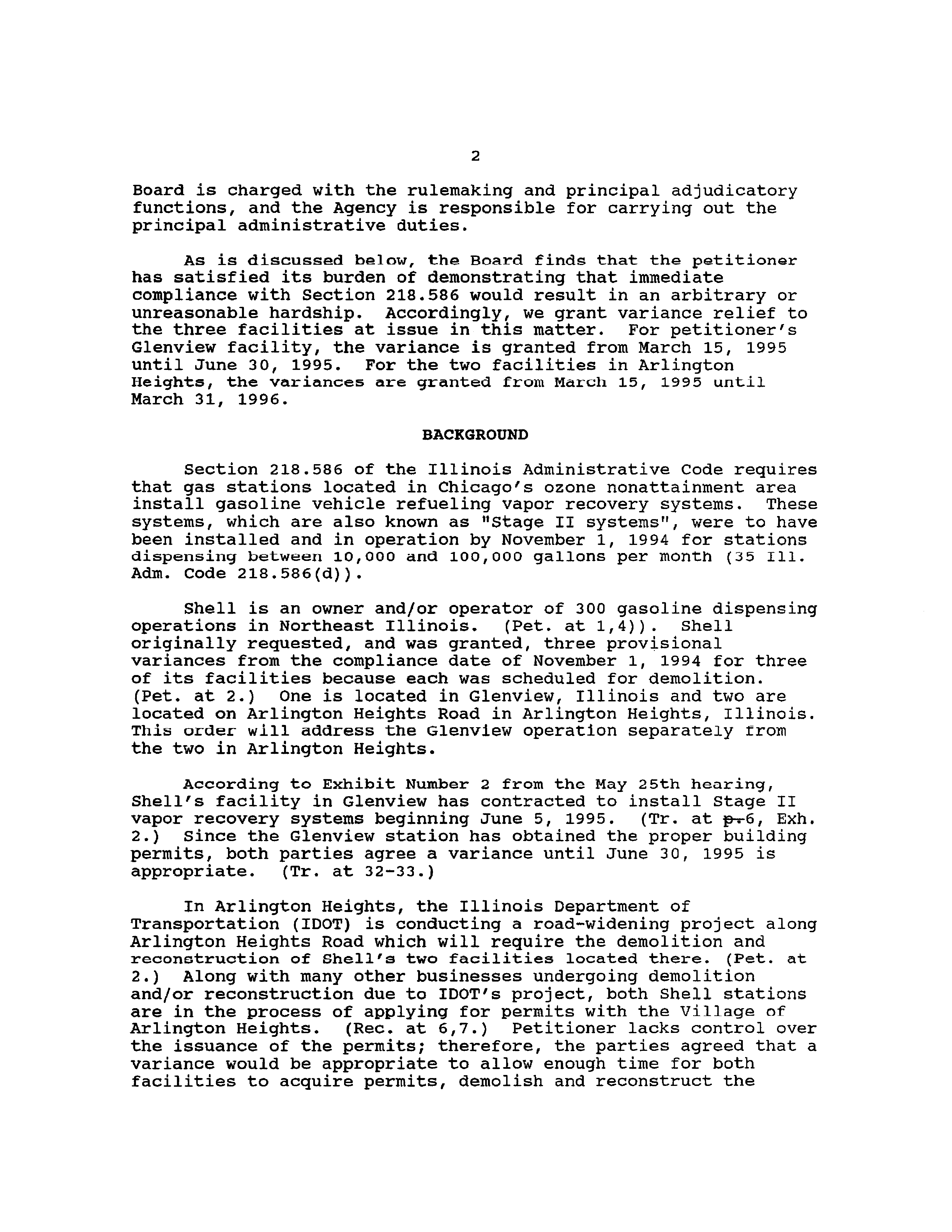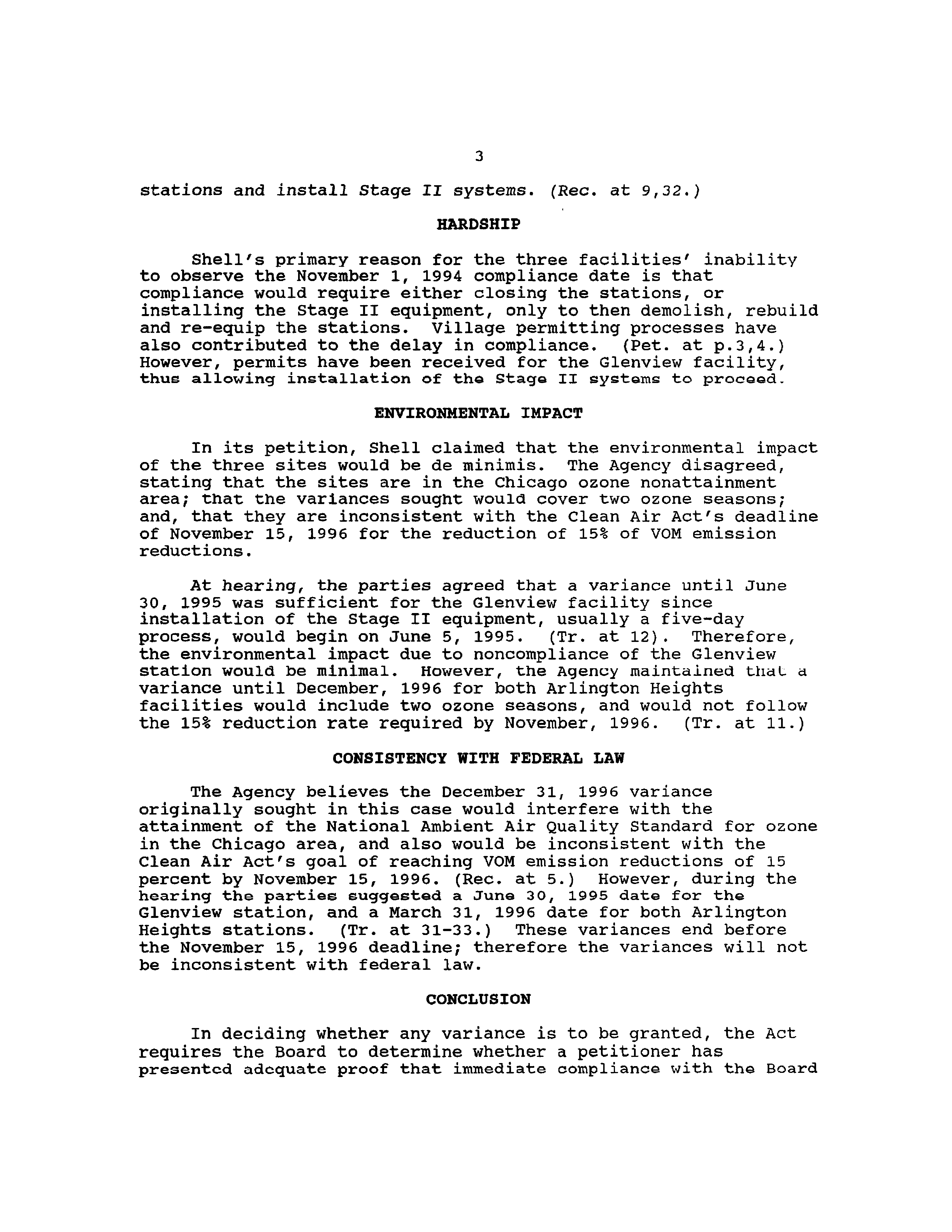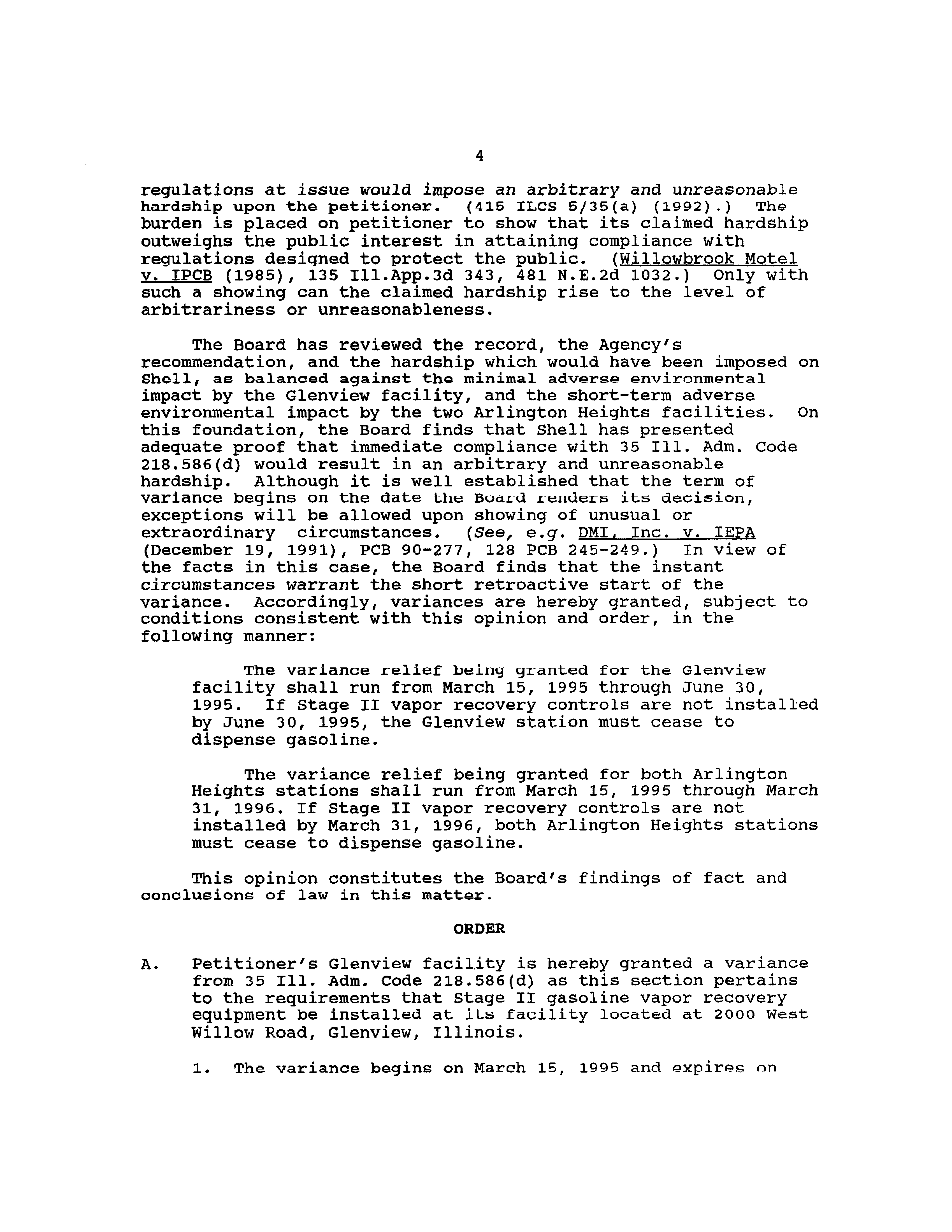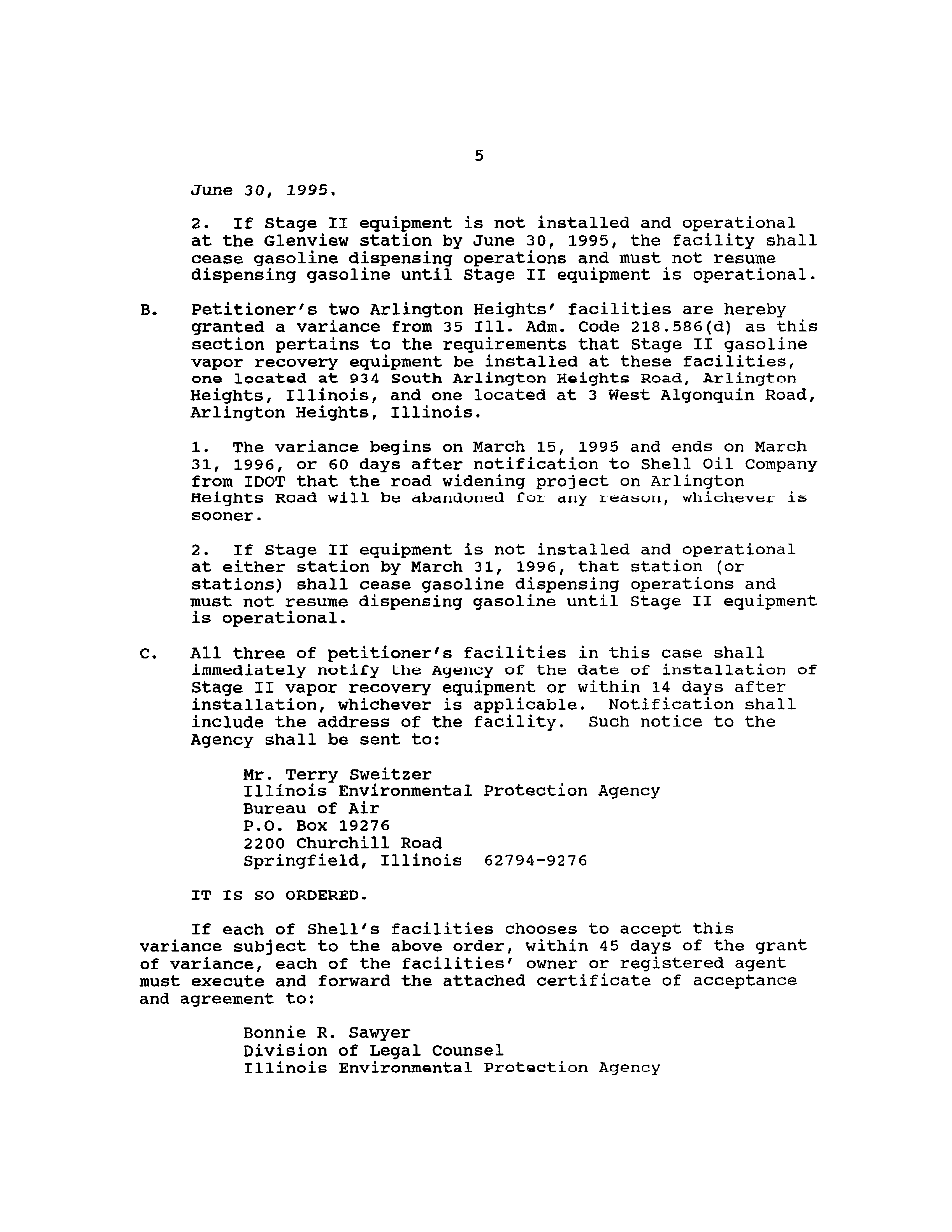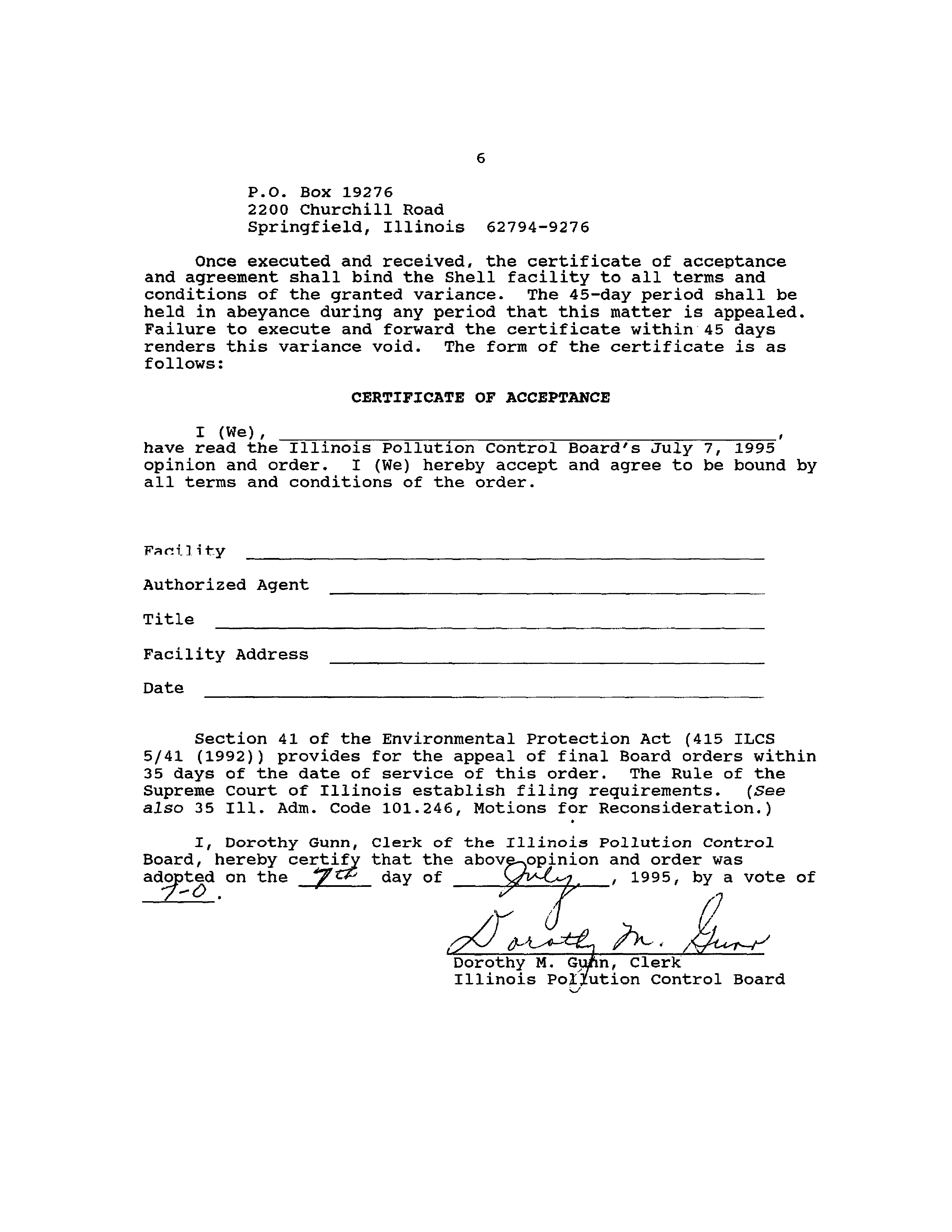ILLINOIS POLLUTION CONTROL BOARD
July
7,
1995
SHELL OIL COMPANY,
)
)
Petitioner,
)
V.
)
PCB 95—102
(Variance—Air)
ILLINOIS ENVIRONMENTAL
)
PROTECTION AGENCY,
)
Respondent.
FRANK M. GRENARD OF JONES, WARE & GRENARD APPEARED ON BEHALF OF
THE
PETITIONER.
BONNIE R. SAWYER APPEARED ON BEHALF OF THE RESPONDENT.
OPINION
AND
ORDER OF THE BOARD
(J. Theodore Meyer):
On March 15,
1995,
Shell Oil Company
(Shell)
filed a
petition for
variance
from
35 Iii. Adm. Code 218.506 seeking
to
extend
the date for compliance with requirements for
Stage
II
gasoline vapor recovery from November 1,
1994 to December 31,
1996 for three of its retail gasoline dispensing facilities.
(Pet.
at
1.)1
All three facilities seeking a variance are
located in the Chicago ozone nonattainment area in Illinois.
(Tr.
at
10.)
A public hearing was held on May 25, 1995 before the Board
hearing officer,
Deborah Frank,
in Chicago,
Illinois.
No members
of the public were
present.
The Illinois
Environnient~t1
Protection Agency (Agency)
filed its recommendation prior to the
hearing on May 1,
1995
and amended its recommendation during the
hearing.
Both parties declined
to
file post-hearing briefs.
The Board’s responsibility in this matter arises from the
Illinois Environmental Act (Act)
(415 ILCS 5/1 et seq.
(1992).)
The Board is charged therein with the responsibility to “grant
individual variances beyond the limitations prescribed
in this
Act, whenever it is found upon presentation of adequate proof,
that compliance with any rule or regulation, requirement or order
of the Board would impose an arbitrary or unreasonable hardship”.
(415 ILCS 5/35 (a)
(1992).)
More generally, the Board’s
responsibility
in this matter
is based on
the system of checks
and balances integral to Illinois environmental governance:
the
‘Petitioner’s petition shall be referred to as
(Pet.
at
_.);
the Agency Recommendation shall be referred to as
(Rec. at
_.);
and, the hearing transcript shall be referred to as
(Tr. at
_.).
2
Board is charged with the rulemaking and principal adjudicatory
functions, and the Agency is responsible for carrying out the
principal administrative duties.
As is discussed below, the Board finds that the petitioner
has satisfied its burden of demonstrating that immediate
compliance with Section 218.586 would result in an arbitrary or
unreasonable hardship.
Accordingly, we grant variance relief to
the three facilities at issue in this matter.
For petitioner’s
Glenview facility, the variance is granted from March
15,
1995
until June 30,
1995.
For the two facilities in Arlington
Heights, the variances are granted from March 15, 1995 until
March 31,
1996.
BACKGROUND
Section 218.586 of the Illinois Administrative Code requires
that gas stations located in Chicago’s ozone nonattainment area
install gasoline vehicle refueling vapor recovery systems.
These
systems,
which are also known as “stage ii systems”, were to have
been installed and in operation by November 1,
1994 for stations
dispensing between 10,000 and 100,000 gallons per month
(35
Ill.
Adm. Code 218.586(d)).
Shell is an owner and/or operator of 300 gasoline dispensing
operations in Northeast Illinois.
(Pet.
at 1,4)).
Shell
originally requested,
and was granted, three provisional
variances from the compliance date of November 1,
1994 for three
of its facilities because each was scheduled for demolition.
(Pet.
at
2.)
One is located in Glenview,
Illinois and two are
located on Arlington Heights Road in Arlington Heights, Illinois.
This order will address the Glenview operation separately trom
the two in Arlington Heights.
According to Exhibit Number
2 from the May 25th hearing,
Shell’s facility in Glenview has contracted to install Stage II
vapor recovery systems beginning June
5,
1995.
(Tr. at
p-r6,
Exh.
2.)
Since the Glenview station has obtained the proper building
permits, both parties agree a variance until June
30,
1995 is
appropriate.
(Tr. at 32-33.)
In Arlington Heights, the Illinois Department of
Transportation (IDOT)
is conducting a road-widening project along
Arlington Heights Road which will require the demolition and
reconstruction of Shell’s two facilities located there.
(Pet.
at
2.)
Along with many other businesses undergoing demolition
and/or reconstruction due to IDOT’s project, both Shall stations
are in the process of applying for permits with the village of
Arlington Heights.
(Rec.
at 6,7.)
Petitioner lacks control over
the issuance of the permits; therefore,
the parties agreed that a
variance would be appropriate to allow enough time for both
facilities to acquire permits, demolish and reconstruct the
3
stations
and
install
Stage
II
systems.
(Rec.
at
9,32.)
HARDSHIP
Shell’s primary reason for the three facilities’ inability
to observe the November
1,
1994 compliance date
is that
compliance would require either closing the stations, or
installing the Stage II equipment,
only to then demolish, rebuild
and re-equip the stations.
Village permitting processes have
also contributed to the delay in compliance.
(Pet.
at p.3,4.)
However, permits have been received for the Glenview facility,
thus allowing installation of the Stags
II systems to procsscL
ENVIRONMENTAL IMPACT
In its petition, Shell claimed that the environmental impact
of the three sites would be de minimis.
The Agency disagreed,
stating that the sites are in the Chicago ozone nonattainment
area; that the variances sought would cover two ozone seasons;
and, that they are inconsistent with the Clean Air Act’s deadline
of November 15,
1996 for the reduction of 15
of VOM emission
reductions.
At hearing,
the
parties agreed that a variance until June
30,
1995 was sufficient for the Glenview facility since
installation of the Stage II equipment,
usually a five-day
process, would begin on June 5,
1995.
(Tr.
at
12).
Therefore,
the environmental impact due to noncompliance of the Glenview
station would be minimal.
However, the Agency maintained
thaL
a
variance until December, 1996 for both Arlington Heights
facilities would include two ozone seasons, and would not follow
the 15
reduction rate required by November,
1996.
(Tr.
at
11.)
CONSISTENCY WITH FEDERAL LAW
The Agency believes the December 31,
1996 variance
originally sought in this case would interfere with the
attainment of the National Ambient Air Quality Standard for ozone
in the Chicago area,
and also would be inconsistent with the
Clean Air Act’s goal of reaching VON emission reductions of
15
percent by November
15,
1996.
(Rec. at
5..)
However,
during the
hearing the parties suggested
a June 30,
1995 date for the
Glenview station, and a March 31, 1996 date for both Arlington
Heights stations.
(Tr. at 31-33.)
These variances end before
the November 15,
1996 deadline; therefore the variances will not
be inconsistent with federal law.
CONCLUSION
In deciding whether any variance is to be granted, the Act
requires the Board to determine whether a petitioner has
presented
adoquate
proof that immediate compliance
with the Board
4
regulations
at
issue would impose
an
arbitrary
and unreasonable
hardship
upon
the
petitioner.
(415 ILCS 5/35 (a)
(1992).)
The
burden
is
placed
on
petitioner
to
show
that
its
claimed
hardship
outweighs the public interest in attaining compliance with
regulations desiqned to protect the public.
(Willowbrook Motel
v.
IPCB
(1985),
135 Il1.App.3d 343,
481 N.E.2d 1032.)
Only with
such a showing can the claimed hardship rise to the level of
arbitrariness
or
unreasonableness.
The
Board
has
reviewed
the record, the Agency’s
recommendation,
and
the
hardship
which
would
have
been
imposed
on
Shell,
as
balanced against the minimal adverse environmental
impact by the Glenview facility, and the short-term adverse
environmental
impact
by
the
two
Arlington
Heights facilities.
On
this
foundation,
the
Board
finds
that
Shell
has
presented
adequate
proof
that
immediate
compliance
with
35 Ill. Adm.
Code
218.586(d) would result in an arbitrary and unreasonable
hardship.
Although it
is well established that the term of
variance begins on the date
the Board renders its decision,
exceptions
will
be
allowed
upon showing of unusual or
extraordinary
circumstances.
(See,
e.g.
DM1,
Inc.
v.
IEPA
(December 19, 1991), PCB 90—277,
128 PCB 245—249.)
In view of
the facts in this case, the Board finds that the instant
circumstances warrant the short retroactive start of the
variance.
Accordingly, variances are hereby granted, subject to
conditions consistent with this opinion and order,
in the
following
manner:
The variance relief being granted for the Glenview
facility shall run from March 15,
1995 through June 30,
1995.
If
Stage
II
vapor
recovery
controls
are
not
installed
by
June
30,
1995,
the Glenview station must cease to
dispense
gasoline.
The
variance
relief
being
granted
for
both
Arlington
Heights
stations
shall
run
from
March
15,
1995
through
March
31,
1996.
If Stage
II vapor recovery controls are not
installed by March 31, 1996,
both Arlington Heights stations
must cease to dispense gasoline.
This opinion constitutes the Board’s findings of fact and
conclusions
of
law
in
this
matter.
ORDER
A.
Petitioner’s Glenview facility is hereby granted a variance
from 35 Ill. Adm. Code 218.586(d)
as this section pertains
to the requirements that Stage II gasoline vapor recovery
equipment be installed at its facility located at 2000
West
Willow Road, Glenview, Illinois.
1.
The variance begins on March
15,
1995 and
expir~c~on
5
June
30,
1995.
2.
If Stage II equipment
is not installed and operational
at the Glenview station by June
30,
1995,
the facility shall
cease gasoline dispensing operations and must not resume
dispensing
gasoline
until
Stage II equipment is operational.
B.
Petitioner’s two Arlington Heights’ facilities are hereby
granted a variance from 35 Ill. Adm. Code 218.586(d)
as this
section pertains to the requirements that Stage II gasoline
vapor recovery equipment be installed at these facilities,
one located at 934
South
Arlington
Heights
Road1
Arlington
Heights,
Illinois, and one located at
3 West Algonquin Road,
Arlington
Heights,
Illinois.
1.
The
variance
begins
on
March
15,
1995
and
ends
on
March
31,
1996,
or 60 days after notification to Shell Oil Company
from IDOT that the road widening project on Arlington
Heights Road will
be abandoned
for any reason,
whichever
is
sooner.
2.
If Stage II equipment is not installed and operational
at
either
station
by
March
31,
1996,
that
station
(or
stations)
shall cease gasoline dispensing operations and
must not resume dispensing gasoline until Stage II equipment
is
operational.
C.
All three of petitioner’s facilities
in this case shall
immediately notify the Agency of the date
of installation
of
Stage II vapor recovery equipment or within 14 days after
installation, whichever
is applicable.
Notification shall
include the address of the facility.
Such notice to the
Agency shall be sent to:
Mr.
Terry
Sweitzer
Illinois Environmental Protection Agency
Bureau
of
Air
P.O. Box 19276
2200
Churchill
Road
Springfield, Illinois
62794—9276
IT IS
SO
ORDERED.
If each of Shell’s facilities chooses to accept this
variance subject to the above order, within 45 days of the grant
of variance, each of the facilities’ owner or registered agent
must
execute
and
forward
the
attached
certificate
of
acceptance
and
agreement
to:
Bonnie R. Sawyer
Division of Legal Counsel
Illinois Environmental Protection Agency
6
P.O.
Box
19276
2200
Churchill
Road
Springfield,
Illinois
62794—9276
Once
executed
and
received,
the
certificate
of
acceptance
and agreement shall bind the Shell
facility to all terms and
conditions of the granted variance.
The 45-day period shall be
held in abeyance during any period that this matter is appealed.
Failure to execute and forward the certificate within 45 days
renders this variance void.
The form of the certificate is as
follows:
CERTIPICATE OP ACCEPTANCE
I
(We),
have read the Illinois Pollution Control Board’s July 7,
1995
opinion and order.
I
(We) hereby accept and agree to be bound by
all terms and conditions of the order.
Fact
1. i
ty
Authorized Agent
_________________________________________
Title
Facility
Address
__________________________________________
Date
Section 41 of the Environmental Protection Act
(415 ILCS
5/41
(1992)) provides for the appeal of final Board orders within
35
days
of
the
date
of
service
of
this
order.
The
Rule
of
the
Supreme
Court
of
Illinois
establish
filing
requirements.
(See
also
35 Ill. Adm.
Code 101.246, Motions f?r Reconsideration.)
I, Dorothy Gunn,
Clerk of the Illinois Pollution Control
Board, hereby certi~’that the abovp~opinionand order was
ad7t~don
the
7
day of
_____________,
1995, by a vote of
Dorothy M.
GWIn,
Clerk
Illinois PoiZution Control Board
.-J
